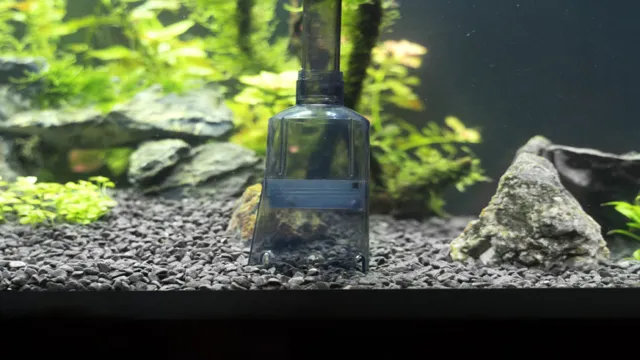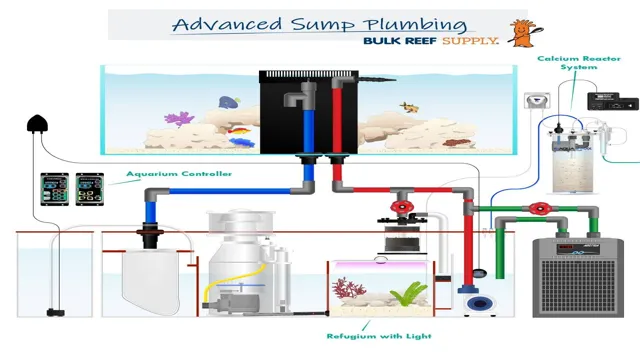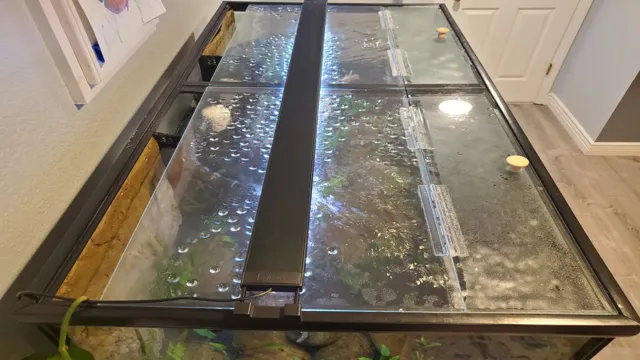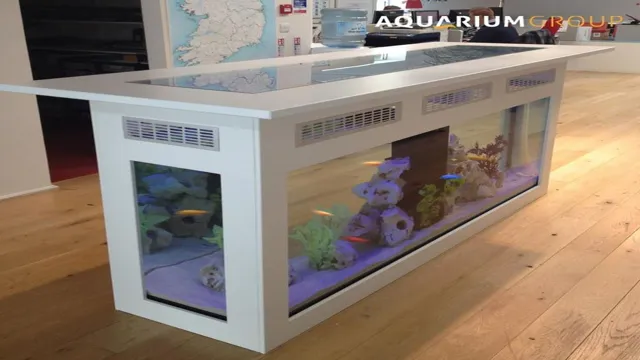Have you ever had a problem with your aquarium’s glass bowing due to the water pressure? It’s a common issue, especially with larger tanks. One solution to this problem is to add a center brace. A center brace is a bar that runs across the center of the aquarium, providing extra support and preventing the glass from bowing.
Not only does a center brace prevent your aquarium from bowing, but it can also add aesthetic value. It adds a unique design element to your aquarium and can make it a focal point in your home. You can choose a center brace that fits the style and design of your tank, such as a clear, black, or metallic brace.
Installing a center brace is relatively easy and affordable. You can purchase a center brace kit online or at your local pet store. The kit typically comes with everything you need, including the bar, end caps, and suction cups.
You simply attach the suction cups to the aquarium’s glass on either side of the center and then snap the bar into place. In conclusion, adding a center brace to your aquarium not only solves the issue of glass bowing but also enhances its visual appeal. It’s a simple and affordable solution that any aquarium owner can do themselves.
Consider adding a center brace to your tank today and enjoy a more resilient and attractive aquarium.
Why Do You Need a Center Brace?
Adding a center brace to an aquarium is a wise decision and can provide added stability to your tank. It’s not uncommon for a fish tank to become warped or uneven over time, which can lead to a dangerous situation for your aquatic pets. A center brace can help prevent this from happening by distributing the weight of the water and the tank evenly.
This is especially important for larger tanks that hold more water and have a higher risk of bowing. Without a center brace, your aquarium can crack, leak, or even collapse, resulting in damage to your home and harm to your fish. In short, adding a center brace is a simple way to ensure the safety and longevity of your aquarium.
Support and Stability
If you’re looking for support and stability for your furniture or shelving, a center brace is a must-have. A center brace can be a crucial component for ensuring the longevity and durability of your furniture, as it adds additional support to the structure. Without a center brace, furniture can become wobbly, unsteady and potentially hazardous.
Center braces help redistribute the weight and pressure that can be placed on a furniture piece, which makes it less likely to break. Think of a center brace as the backbone of your piece, keeping everything in place and sturdy. So whether you’re looking to build your own furniture or simply enhance an existing piece, investing in a center brace is a wise decision that pays off in the long run.

Prevention of Glass Cracking
If you’re wondering why you need a center brace for your glass, the answer is quite simple: to prevent cracking, especially for larger pieces. Without a center brace, the weight of the glass can cause it to bend or sag in the middle, which puts immense pressure on the edges. Over time, this can weaken the glass and make it more susceptible to cracking or shattering.
By adding a center brace, you distribute the weight of the glass more evenly, reducing the risk of breakage. Think of it like a bridge that needs sturdy support beams to hold it up. Without those beams, the weight of the cars crossing the bridge would cause it to collapse.
Similarly, a large piece of glass needs support to ensure its longevity and prevent damage. So, if you have a piece of glass that’s particularly large or heavy, consider adding a center brace to keep it in optimal condition.
Supplies Needed
Adding a center brace to an aquarium is an important step in ensuring the stability of your tank. To do this, you will need some supplies. You’ll need a plastic or glass brace, a clean cloth, and silicone sealant.
Before adding the brace, take some time to clean the area where it will be placed. Once that’s done, apply a thin layer of silicone sealant and carefully place the brace on top. You want to make sure that it is centered properly.
After the brace is in place, apply a bead of silicone sealant around both sides of the brace to secure it fully. Let it dry for at least 24 hours before adding water to the tank. With the brace securely in place, you can rest assured that your aquarium will remain stable and secure. (See Also: How to Get Rid of Ammonia from a Discus Aquarium: A Comprehensive Guide)
Center Brace Kit
The Center Brace Kit is a vital component for those looking to build sturdy and reliable structures. To assemble the kit, you will need a variety of supplies, including fasteners, washers, drill bits, and a protective saw for cutting brackets to size. It is important to choose the appropriate material for your braces, as the strength of your structure will depend on it.
Galvanized steel and aluminum are popular options due to their durability and resistance to rusting, although wood is another common choice. When constructing your center braces, it is important to follow manufacturer instructions carefully to ensure your brace is as solid as possible. A strong center brace kit can make all the difference in the stability and longevity of your structure, so it’s essential to select high-quality materials and be meticulous in its assembly.
Measuring Tape
When it comes to measuring tape, there are a few supplies that you’ll need to ensure that you get accurate measurements every time. Of course, the most obvious one is the measuring tape itself. You’ll want to choose one that is durable and easy to read, with clear markings that won’t wear off over time.
Additionally, you’ll need a surface to measure on – whether that’s a table or a floor – that is flat and even. An uneven surface can skew your measurements, so it’s important to make sure that everything is stable before you begin. Finally, you may want to consider a pencil or other writing utensil to mark your measurements as you go.
This can help you keep track of which measurement corresponds to which object, and prevent confusion down the line. By having these supplies on hand, you’ll be able to take accurate measurements with ease – no matter what you’re measuring!
Marker
If you’re looking to create vibrant and bold artwork or simply want to add a pop of color to a project, then you will need a set of high-quality markers. To begin your marker project, you will need to have the right supplies on hand. Firstly, choose markers made by a reputable brand such as Prismacolor, Copic, or Staedtler.
Quality markers offer a range of color, blendability, and ink longevity, ensuring your artwork lasts as long as you do. Also, consider the type of marker tip desired for your project. Different tips, such as fine point, brush, or chisel, offer different lines and designs, giving your artwork a unique look.
Don’t forget to buy a variety of colors to enhance your palette and allow creativity to flow. With an array of markers on hand, your imagination and creativity are limitless.
Drill
When it comes to drilling, having the right supplies on hand can make all the difference. One of the most important things you’ll need is a good quality drill. There are plenty of different types to choose from, including cordless drills, electric drills, and hammer drills.
You’ll want to consider factors like the size and weight of the drill, as well as its power and speed. Along with the drill itself, make sure you have a variety of drill bits in different sizes and materials, depending on the type of project you’re working on. It’s also a good idea to have safety glasses, ear protection, and a dust mask on hand to keep yourself safe and comfortable while you’re drilling.
Overall, with the right supplies in your arsenal, you’ll be able to tackle any drilling project with confidence.
Silicone Adhesive
If you’ve ever worked on a project that required silicone adhesive, you know that having the right supplies on hand is essential. To get started, you will need the silicone adhesive itself, which can be found at most hardware or home improvement stores. You will also need a caulking gun to apply the adhesive in a precise and controlled manner.
In addition, you may want to have some rubbing alcohol and a clean cloth on hand to prepare the surface and ensure that it is free of dirt and debris. Finally, depending on the project, you may need other supplies such as masking tape, a putty knife, or sandpaper to help with application and finishing. By having all of these supplies organized and within reach, you can make the silicone adhesive application process smoother, easier, and more efficient.
Step-by-Step Instructions
Adding a center brace to an aquarium can be a crucial step in reinforcing the structural integrity of your tank. Luckily, it’s a relatively simple process that can be accomplished with just a few tools and some careful planning. To begin, measure the length and width of your aquarium to determine the length of the center brace needed. (See Also: How to Buff Scratches Out of Aquarium Glass: A Step-by-Step Guide)
Next, purchase a sturdy piece of metal or plastic tubing that can withstand the weight and pressure of the water in your tank. Once you have the center brace, position it in the center of your aquarium and use aquarium-safe silicone adhesives to secure it in place. Then, let the adhesive dry completely before filling the tank with water.
With your new center brace in place, you’ll enjoy added peace of mind knowing that your aquarium is better equipped to handle the weight and stress of a full tank.
Step 1: Measure the Distance Between the Tank’s Two Sides
Are you ready to set up a new fish tank? It might seem overwhelming, but it’s actually quite simple if you follow a few key steps. To start, you’ll want to measure the distance between the tank’s two sides. This is important for a few reasons – it will help you determine the size of the space needed for the tank, as well as the placement of any accessories like filters or heaters.
To measure the distance accurately, simply use a measuring tape to measure from one side of the tank to the other, at the widest point. Be sure to write down the measurement as you go, so you’ll have it handy for future reference. This is just the first step, but it’s an important one to get right if you want to set up a successful fish tank.
Step 2: Mark the Center Point of the Tank
When it comes to installing a water tank, it is crucial to mark the center point before proceeding with any other steps. This will ensure that the tank is correctly positioned and prevent any accidents. To mark the center point, you will need a measuring tape and spray paint.
Begin by measuring the width of the water tank and then divide the measurement by two. This will give you the center point. Stand at one end of the tank and measure the distance from the wall to the center point.
Then, go to the other end of the tank and repeat the process. This will give you two marks on the ground where the center point will be. Finally, use spray paint to mark the center point.
By doing this, you will have accurate measurements for placing the water tank in the correct spot. Remember to double-check your measurements before installing the tank.
Step 3: Install the Center Brace Kit
To install the center brace kit for your equipment, begin by gathering all the necessary tools and parts. Make sure you have a socket wrench, an adjustable wrench, and the center brace kit components, which typically include the brace, mounting bolts, and nuts. Once you have everything ready, take the brace and position it at the center of the equipment’s chassis using the mounting holes as a guide.
Secure the brace in place by tightening the bolts and nuts with your wrenches. It’s important to ensure that the brace is level and straight before tightening everything, as it can affect the overall stability of your equipment. Once you’ve tightened everything up, double-check your work and make sure the brace is securely in place.
With the center brace kit installed, your equipment will have an increased level of stability and durability, providing peace of mind during use. Remember, it’s important to follow the manufacturer’s instructions when installing any components to ensure that they’re installed correctly and safely.
Step 4: Apply Silicone Adhesive to Secure the Brace
Applying silicone adhesive is the final step to ensure that the brace is secure and in place. To begin, clean the area where the brace will be placed and use a dry towel to remove any moisture. Then, apply a small amount of silicone adhesive to the brace, making sure to spread it evenly over the entire surface.
Carefully place the brace in the desired position, making sure it is correctly aligned with the affected area. Next, press the brace firmly into position and hold it there for at least thirty seconds. This will allow the adhesive to set and bond with the skin. (See Also: How to Grow Larger Aquarium Plants: Tips and Tricks for a Vibrant Aquascape)
Finally, make sure that the patient does not move the affected limb or area too much immediately after application. This will give the adhesive enough time to cure and ensure that the brace does not come loose. With these simple steps, application of silicone adhesive can make certain that the brace remains in position and provides the necessary support to the affected area.
Final Thoughts
Adding a center brace to an aquarium might seem like a daunting task, but it’s actually a straightforward process. First and foremost, it’s important to determine the appropriate size and thickness of the brace to ensure it can handle the weight of the tank without bending or breaking. It’s recommended to use a solid piece of material, such as metal or plastic, that can be cut to size and attached securely to the top of the tank’s frame using screws or adhesive.
The center brace will provide additional support and stability to prevent bowing or cracking, especially in larger aquariums. Remember to measure twice and cut once, and always follow safety precautions such as wearing eye protection and using sharp tools with care. With some patience and attention to detail, adding a center brace can help ensure the longevity and safety of your aquatic habitat.
Conclusion
Congratulations! You have successfully learned how to add a center brace to your aquarium. Just remember, when it comes to aquarium maintenance, adding a center brace is just the tip of the iceberg. So, make sure to stay tuned for the next exciting episode of Aquarium DIY, where we’ll dive deep into the world of fish tank enhancements and unveil more secrets to turn your underwater world into an aquatic paradise!”
FAQs
What is a center brace in an aquarium?
A center brace in an aquarium refers to a structural component that runs along the center of the tank, providing support and preventing the glass panels from bowing outwards.
How do I know if my aquarium needs a center brace?
Aquariums with longer lengths or widths may require a center brace to prevent the glass from bowing. It’s best to consult the manufacturer’s guidelines or an experienced aquarist for advice.
Can I add a center brace to an existing aquarium?
It is possible to add a center brace to an aquarium, but it’s recommended to seek professional advice to ensure the modifications are done correctly and don’t compromise the structural integrity of the tank.
What materials are used to make a center brace?
Center braces are typically made of sturdy materials, such as aluminum or acrylic, that can withstand the weight and pressure of large volumes of water in the aquarium.
What are the benefits of having a center brace in an aquarium?
A center brace helps to distribute the weight of the water evenly, which can prevent the glass from cracking or breaking. It also provides additional support for the hood or light fixtures above the tank.
Can I remove a center brace from my aquarium?
Removing a center brace can compromise the structural integrity of the aquarium and is not recommended. It’s best to leave any modifications to a professional aquarist.
How can I maintain the center brace in my aquarium?
Regular cleaning and inspection of the center brace can help prevent any damage or wear and tear. It’s important to avoid placing heavy objects on the brace and keep the area around it clear to prevent damage.







